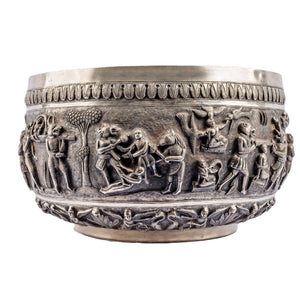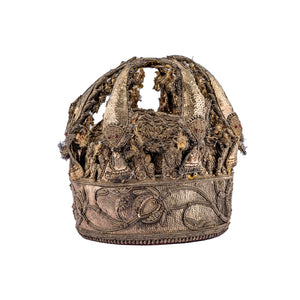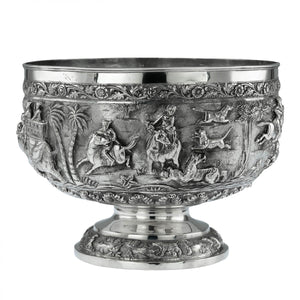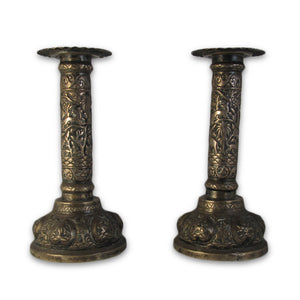Lucknow silver had been produced for centuries before British rule commenced in 1858. The silver had traditionally been produced for the Nawabs, the Muslim rulers, who had dedicated silversmiths in their service.
Under the Raj, silversmiths usually adopted British forms, save for some complex bowls of unusual shape and distinctive form. Lucknow silver can be recognized by its four motifs: jungle scenes, coriander flowers, hunting scenes, and village life. A scrolling fish pattern or feet of fish shape are a design element often used on Lucknow silver. The fish derive from the iconography of the Royal Coat of Arms of the Nawabs of Lucknow where they are a principal design element. The arms of the Kings of Oudh, incorporated twin fishes centered between two tigers passant with female winged mermaid figures over the tigers.
Lucknow silversmiths often incorporated decorative styles from other regions of India, including: Kutch, Calcutta, Madras and Kashmir. The maker sometimes marked the silver with his mark or ’signature’ to the underside. This ’signature’ usually took the form of an elaborately engraved animal or geometric motif which identified him. Silver from Lucknow can be found in England and other European countries today because it was brought back by colonial administrators and European travellers during the nineteenth and early twentieth centuries .
Under the Raj, silversmiths usually adopted British forms, save for some complex bowls of unusual shape and distinctive form. Lucknow silver can be recognized by its four motifs: jungle scenes, coriander flowers, hunting scenes, and village life. A scrolling fish pattern or feet of fish shape are a design element often used on Lucknow silver. The fish derive from the iconography of the Royal Coat of Arms of the Nawabs of Lucknow where they are a principal design element. The arms of the Kings of Oudh, incorporated twin fishes centered between two tigers passant with female winged mermaid figures over the tigers.
Lucknow silversmiths often incorporated decorative styles from other regions of India, including: Kutch, Calcutta, Madras and Kashmir. The maker sometimes marked the silver with his mark or ’signature’ to the underside. This ’signature’ usually took the form of an elaborately engraved animal or geometric motif which identified him. Silver from Lucknow can be found in England and other European countries today because it was brought back by colonial administrators and European travellers during the nineteenth and early twentieth centuries .



